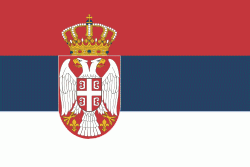Donji Milanovac (Donji Milanovac)
Donji Milanovac (Доњи Милановац, ) is a town in eastern Serbia. It is situated in the Majdanpek municipality, in the Bor District. It is located on the right bank of Lake Đerdap on the Danube. The population of the town is 2,410 people (2011 census). Its name means "Lower Milanovac" (there is an Upper Milanovac, as well).
The management office of Đerdap national park is located in the town.
It has been nicknamed a "town of 100,000 roses".
The town is located on the right bank of Lake Đerdap on the Danube, and is located in the Đerdap national park. The Miroč mountain lies between Donji Milanovac and Tekija and further to the south are the Kučaj mountains. The Miroč is known for the abundance of the medicinal herbs while the area surrounding the town is covered in lush deciduous forests.
Via Danube, Donji Milanovac is 198 km away from Belgrade. It is situated in the Veliki Kazan gorge, a section of the composite Iron Gate gorge. At Donji Milanovac, the Danube is 2000 m wide, while at Veliki Kazan is 170 m wide and 90 m deep. The locality on which the settlement is today used to be called "Trkulja's gallery", after a local artist. A balloon station "Pena" was situated on location, as prior to the discovery of radio, balloons were used for signalization during the navigation through the canal.
Prior to the construction of the Iron Gate I Hydroelectric Power Station, which dammed the Danube and created the Lake Đerdap in 1967–72, belugas from the Black Sea reached the gorge, travelling upstream for 1000 km. Specimen, up to 300 kg, used to be fished in Donji Milanovac. The dam prevents belugas from swimming upstream since, so the largest fish in the lake now is wels catfish, with rare specimen reaching 100 kg.
The management office of Đerdap national park is located in the town.
It has been nicknamed a "town of 100,000 roses".
The town is located on the right bank of Lake Đerdap on the Danube, and is located in the Đerdap national park. The Miroč mountain lies between Donji Milanovac and Tekija and further to the south are the Kučaj mountains. The Miroč is known for the abundance of the medicinal herbs while the area surrounding the town is covered in lush deciduous forests.
Via Danube, Donji Milanovac is 198 km away from Belgrade. It is situated in the Veliki Kazan gorge, a section of the composite Iron Gate gorge. At Donji Milanovac, the Danube is 2000 m wide, while at Veliki Kazan is 170 m wide and 90 m deep. The locality on which the settlement is today used to be called "Trkulja's gallery", after a local artist. A balloon station "Pena" was situated on location, as prior to the discovery of radio, balloons were used for signalization during the navigation through the canal.
Prior to the construction of the Iron Gate I Hydroelectric Power Station, which dammed the Danube and created the Lake Đerdap in 1967–72, belugas from the Black Sea reached the gorge, travelling upstream for 1000 km. Specimen, up to 300 kg, used to be fished in Donji Milanovac. The dam prevents belugas from swimming upstream since, so the largest fish in the lake now is wels catfish, with rare specimen reaching 100 kg.
Map - Donji Milanovac (Donji Milanovac)
Map
Country - Serbia
 |
 |
| Flag of Serbia | |
Continuously inhabited since the Paleolithic Age, the territory of modern-day Serbia faced Slavic migrations in the 6th century, establishing several regional states in the early Middle Ages at times recognised as tributaries to the Byzantine, Frankish and Hungarian kingdoms. The Serbian Kingdom obtained recognition by the Holy See and Constantinople in 1217, reaching its territorial apex in 1346 as the Serbian Empire. By the mid-16th century, the Ottomans annexed the entirety of modern-day Serbia; their rule was at times interrupted by the Habsburg Empire, which began expanding towards Central Serbia from the end of the 17th century while maintaining a foothold in Vojvodina. In the early 19th century, the Serbian Revolution established the nation-state as the region's first constitutional monarchy, which subsequently expanded its territory. Following casualties in World War I, and the subsequent unification of the former Habsburg crownland of Vojvodina with Serbia, the country co-founded Yugoslavia with other South Slavic nations, which would exist in various political formations until the Yugoslav Wars of the 1990s. During the breakup of Yugoslavia, Serbia formed a union with Montenegro, which was peacefully dissolved in 2006, restoring Serbia's independence as a sovereign state for the first time since 1918. In 2008, representatives of the Assembly of Kosovo unilaterally declared independence, with mixed responses from the international community while Serbia continues to claim it as part of its own sovereign territory.
Currency / Language
| ISO | Currency | Symbol | Significant figures |
|---|---|---|---|
| RSD | Serbian dinar | дин or din. | 2 |
| ISO | Language |
|---|---|
| BS | Bosnian language |
| HU | Hungarian language |
| SR | Serbian language |















